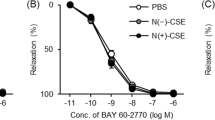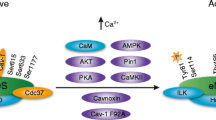Abstract
In isolated cells, soluble guanylyl cyclase (sGC) activity is regulated by exogenous nitric oxide (NO) via downregulation of expression and posttranslational S-nitrosylation. The aim of this study was to investigate whether such regulatory mechanism impact on endothelium-dependent vasodilation in a newly developed mouse strain carrying an endothelial-specific overexpression of eNOS (eNOS++). When compared with transgene negative controls (eNOSn), eNOS++-mice showed a 3.3-fold higher endothelial-specific aortic eNOS expression, increased vascular cGMP and VASP phosphorylation, a L-nitroarginine (L-NA)-inhibitable decrease in systolic blood pressure, but normal levels of peroxynitrite and nitrotyrosine formation, endothelium-dependent aortic vasodilation and vasodilation to NO donors. Western blot analysis for sGC showed similar protein levels of sGC-α1 and sGC-β1 subunits in eNOSn and eNOS++. In striking contrast, the activity of isolated sGC was strongly decreased in lungs of eNOS++. Semiquantitative evaluation of sGC-β1-S-nitrosylation demonstrated that this loss of sGC activity is associated with increased nitrosylation of the enzyme in eNOS++, a difference that disappeared after L-NA-treatment. Our data suggest the existence of a physiologic NO-dependent posttranslational regulation of vascular sGC in mammals involving S-nitrosylation as a key mechanism. Because this mechanism can compensate for reduction in vascular NO bioavailability, it may mask the development of endothelial dysfunction.





Similar content being viewed by others
References
Barnett DJ, McAninly J, Williams DLH (1994) Transnitrosation between nitrosothiols and thiols. J Chem Soc Perkin Trans 21131–21133. doi:10.1039/P29940001131
Batenburg WW, De Vries R, Saxena PR, Danser AH (2004) L-S-Nitrosothiols: endothelium-derived hyperpolarizing factors in porcine coronary arteries? J Hypertens 22:1927–1936
Bellamy TC, Wood J, Goodwin DA, Garthwaite J (2000) Rapid desensitization of the nitric oxide receptor, soluble guanylyl cyclase, underlies diversity of cellular cGMP responses. Proc Natl Acad Sci USA 97:2928–2933
Brandes RP, Kim DY, Schmitz-Winnenthal FH, Amidi M, Gödecke A, Mülsch A, Busse R (2000) Increased nitrovasodilator sensitivity in endothelial nitric oxide synthase knockout mice—role of soluble guanylyl cyclase. Hypertension 35:231–236
Buechler WA, Nakane M, Murad F (1991) Expression of soluble guanylate cyclase activity requires both enzyme subunits. Biochem Biophys Res Commun 174:351–357. doi:10.1016/0006-291X(91)90527-E
Desjardins F, Lobysheva I, Pelat M, Gallez B, Feron O, Dessy C, Balligand JL (2008) Control of blood pressure variability in caveolin-1-deficient mice: role of nitric oxide identified in vivo through spectral analysis. Cardiovasc Res 79:527–536. doi:10.1093/cvr/cvn080
Dikalov S, Fink B (2005) ESR techniques for the detection of nitric oxide in vivo and in tissues. Methods Enzymol 396:597–610. doi:10.1016/S0076-6879(05)96052-7
Drab M, Verkade P, Elger M, Kasper M, Lohn M, Lauterbach B, Menne J, Lindschau C, Mende F, Luft FC, Schedl A, Haller H, Kurzchalia TV (2001) Loss of caveolae, vascular dysfunction, and pulmonary defects in caveolin-1 gene-disrupted mice. Science 293:2449–2452. doi:10.1126/science.1062688
Filippov G, Bloch DB, Bloch KD (1997) Nitric oxide decreases stability of mRNAs encoding soluble guanylate cyclase subunits in rat pulmonary artery smooth muscle cells. J.Clin.Invest. 100:942–948. doi:10.1172/JCI119610
Frantz S, Adamek A, Fraccarollo D, Tillmanns J, Widder JD, Dienesch C, Schafer A, Podolskaya A, Held M, Ruetten H, Ertl G, Bauersachs J (2009) The eNOS enhancer AVE 9488: a novel cardioprotectant against ischemia reperfusion injury. Basic Res Cardiol 104:773–779. doi:10.1007/s00395-009-0041-3
Gewaltig MT, Kojda G (2002) Vasoprotection by nitric oxide: mechanisms and therapeutic potential. Cardiovasc Res 55:250–260. doi:10.1016/S0008-6363(02)00327-9
Godecke A, Schrader J (2000) Adaptive mechanisms of the cardiovascular system in transgenic mice—lessons from eNOS and myoglobin knockout mice. Basic Res Cardiol 95:492–498
Hamid SA, Totzeck M, Drexhage C, Thompson I, Fowkes RC, Rassaf T, Baxter GF (2010) Nitric oxide/cGMP signalling mediates the cardioprotective action of adrenomedullin in reperfused myocardium. Basic Res Cardiol 105:257–266. doi:10.1007/s00395-009-0058-7
Hussain MB, Hobbs AJ, MacAllister RJ (1999) Autoregulation of nitric oxide-soluble guanylate cyclase-cyclic GMP signalling in mouse thoracic aorta. Br J Pharmacol 128:1082–1088. doi:10.1038/sj.bjp.0702874
Ignarro LJ, Cirino G, Casini A, Napoli C (1999) Nitric oxide as a signaling molecule in the vascular system: an overview. J Cardiovasc Pharmacol 34:879–886
Jaffrey SR, Erdjument-Bromage H, Ferris CD, Tempst P, Snyder SH (2001) Protein S-nitrosylation: a physiological signal for neuronal nitric oxide. Nat Cell Biol 3:193–197. doi:10.1038/35055104
Jaffrey SR, Snyder SH (2001) The biotin switch method for the detection of S-nitrosylated proteins. Sci STKE 2001:L1. doi:10.1126/stke.2001.86.pl1
Keefer LK, Nims RW, Davies KM, Wink DA (1996) “NONOates” (1-substituted diazen-1-ium-1, 2-diolates) as nitric oxide donors: convenient nitric oxide dosage forms. Methods Enzymol 268:281–293. doi:10.1016/S0076-6879(96)68030-6
Kelm M, Rath J (2001) Endothelial dysfunction in human coronary circulation: relevance of the l-arginine-NO pathway. Basic Res Cardiol 96:107–127. doi:10.1007/s003950170061
Kojda G, Hambrecht R (2005) Molecular mechanisms of vascular adaptations to exercise. Physical activity as an effective antioxidant therapy? Cardiovasc Res 67:187–197. doi:10.1016/j.cardiores.2005.04.032
Kojda G, Kottenberg K, Hacker A, Noack E (1998) Alterations of the vascular and the myocardial guanylate cyclase/cGMP-system induced by long-term hypertension in rats. Pharm Acta Helv 73:27–35. doi:10.1016/S0031-6865(97)00044-7
Kojda G, Laursen JB, Ramasamy S, Kent JD, Kurz S, Burchfield J, Shesely EG, Harrison DG (1999) Protein expression, vascular reactivity and soluble guanylate cyclase activity in mice lacking the endothelial nitric oxide synthase: contributions of NOS isoforms to blood pressure and heart rate control. Cardiovasc Res 42:206–213. doi:10.1016/S0008-6363(98)00315-0
Kojda G, Patzner M, Hacker A, Noack E (1998) Nitric oxide inhibits vascular bioactivation of glyceryl trinitrate. A novel mechanism to explain preferential venodilation of organic nitrates. Mol Pharmacol 53:547–554
Kuzkaya N, Weissmann N, Harrison DG, Dikalov S (2005) Interactions of peroxynitrite with uric acid in the presence of ascorbate and thiols: implications for uncoupling endothelial nitric oxide synthase. Biochem Pharmacol 70:343–354. doi:10.1016/j.bcp.2005.05.009
Lauer N, Suvorava T, Rüther U, Jacob R, Meyer A, Harrison DG, Kojda G (2005) Critical involvement of hydrogen peroxide in exercise-induced upregulation of endothelial NO-synthase. Cardiovasc Res 65(1):254–262. doi:10.1016/j.cardiores.2004.09.010
Mayer B, Kleschyov AL, Stessel H, Russwurm M, Munzel T, Koesling D, Schmidt K (2009) Inactivation of soluble guanylate cyclase by stoichiometric S-nitrosation. Mol Pharmacol 75:886–891. doi:10.1124/mol.108.052142
Meyer DJ, Kramer H, Özer N, Coles B, Ketterer B (1994) Kinetics and equilibria of S-nitrosothiol-thiol exchange between glutathione, cysteine, penicillamines and serum albumin. FEBS Lett 345:177–180. doi:10.1016/0014-5793(94)00429-3
Moncada S, Higgs A (1993) Mechanisms of disease: the l-arginine-nitric oxide pathway. N Engl J Med 329:2002–2012
Moncada S, Rees DD, Schulz R, Palmer RMJ (1991) Development and mechanism of a specific supersensitivity to nitrovasodilators after inhibition of vascular nitric oxide synthesis in vivo. Proc Natl Acad Sci USA 88:2166–2170
Mullershausen F, Russwurm M, Koesling D, Friebe A (2003) The enhanced NO-induced cGMP response induced by long-term L-NAME treatment is not due to enhanced expression of NO-sensitive guanylyl cyclase. Vascul Pharmacol 40:161–165. doi:10.1016/S1537-1891(03)00049-1
Ohashi Y, Kawashima S, Hirata K, Yamashita T, Ishida T, Inoue N, Sakoda T, Kurihara H, Yazaki Y, Yokoyama M (1998) Hypotension and reduced nitric oxide-elicited vasorelaxation in transgenic mice overexpressing endothelial nitric oxide synthase (see comments). J Clin Invest 102:2061–2071. doi:10.1172/JCI4394
Oppermann M, Dao VT, Suvorava T, Bas M, Kojda G (2008) Effect of oral organic nitrates on expression and activity of vascular soluble guanylyl cyclase. Br J Pharmacol 155:335–342. doi:10.1038/bjp.2008.269
Ozaki M, Kawashima S, Yamashita T, Hirase T, Namiki M, Inoue N, Hirata K, Yasui H, Sakurai H, Yoshida Y, Masada M, Yokoyama M (2002) Overexpression of endothelial nitric oxide synthase accelerates atherosclerotic lesion formation in apoE-deficient mice. J Clin Invest 110:331–340. doi:10.1172/JCI15215
Riego JA, Broniowska KA, Kettenhofen NJ, Hogg N (2009) Activation and inhibition of soluble guanylyl cyclase by S-nitrosocysteine: involvement of amino acid transport system L. Free Radic Biol Med 47:269–274. doi:10.1016/j.freeradbiomed.2009.04.027
Russwurm M, Koesling D (2004) NO activation of guanylyl cyclase. EMBO J 23:4443–4450. doi:10.1038/sj.emboj.7600422
Sayed N, Baskaran P, Ma X, van den Beuve A AF (2007) Desensitization of soluble guanylyl cyclase, the NO receptor, by S-nitrosylation. Proc Natl Acad Sci USA 104:12312–12317. doi:10.1073/pnas.0703944104
Schmidt K, Andrew P, Schrammel A, Groschner K, Schmitz V, Kojda G, Mayer B (2001) Comparison of neuronal and endothelial isoforms of nitric oxide synthase in stably transfected HEK 293 cells. Am J Physiol Heart Circ Physiol 281:H2053–H2061
Schultz G, Böhme E (1984) Guanylate Cyclase. In: Bergmeyer HU (ed) Methods of enzymatic analysis. Verlag Chemie, Weinheim, FRG, pp 379–389
Scott WS, Nakayama DK (1998) Escherichia coli lipopolysaccharide downregulates soluble guanylate cyclase in pulmonary artery smooth muscle. J Surg Res 80:309–314. doi:10.1006/jsre.1998.5442
Suvorava T, Lauer N, Kojda G (2004) Physical inactivity causes endothelial dysfunction in healthy young mice. J Am Coll Cardiol 44:1320–1327. doi:10.1016/j.jacc.2004.06.030
Szelid Z, Pokreisz P, Liu X, Vermeersch P, Marsboom G, Gillijns H, Pellens M, Verbeken E, Van de WF, Collen D, Janssens SP (2010) Cardioselective nitric oxide synthase 3 gene transfer protects against myocardial reperfusion injury. Basic Res Cardiol 105:169–179. doi:10.1007/s00395-009-0077-4
Weber M, Lauer N, Mulsch A, Kojda G (2001) The effect of peroxynitrite on the catalytic activity of soluble guanylyl cyclase. Free Radic Biol Med 31:1360–1367. doi:10.1016/S0891-5849(01)00706-7
Yamashita T, Kawashima S, Ohashi Y, Ozaki M, Rikitake Y, Inoue N, Hirata K, Akita H, Yokoyama M (2000) Mechanisms of reduced nitric oxide/cGMP-mediated vasorelaxation in transgenic mice overexpressing endothelial nitric oxide synthase. Hypertension 36:97–102
Zhao YY, Zhao YD, Mirza MK, Huang JH, Potula HH, Vogel SM, Brovkovych V, Yuan JX, Wharton J, Malik AB (2009) Persistent eNOS activation secondary to caveolin-1 deficiency induces pulmonary hypertension in mice and humans through PKG nitration. J Clin Invest 119:2009–2018. doi:10.1172/JCI33338
Acknowledgments
This study was supported by the Forschungskommission of the Heinrich-Heine-Universität Düsseldorf (Project 9772 109 to G.K., and project 9772 345 to T.S.).
Conflict of interest
None declared.
Author information
Authors and Affiliations
Corresponding author
Additional information
M. Oppermann and T. Suvorava contributed equally to this work.
Electronic supplementary material
Below is the link to the electronic supplementary material.
Rights and permissions
About this article
Cite this article
Oppermann, M., Suvorava, T., Freudenberger, T. et al. Regulation of vascular guanylyl cyclase by endothelial nitric oxide-dependent posttranslational modification. Basic Res Cardiol 106, 539–549 (2011). https://doi.org/10.1007/s00395-011-0160-5
Received:
Revised:
Accepted:
Published:
Issue Date:
DOI: https://doi.org/10.1007/s00395-011-0160-5




